Hyundai Kona EV 2019 Owner's Manual
Manufacturer: HYUNDAI, Model Year: 2019, Model line: Kona EV, Model: Hyundai Kona EV 2019Pages: 540, PDF Size: 21.84 MB
Page 451 of 540
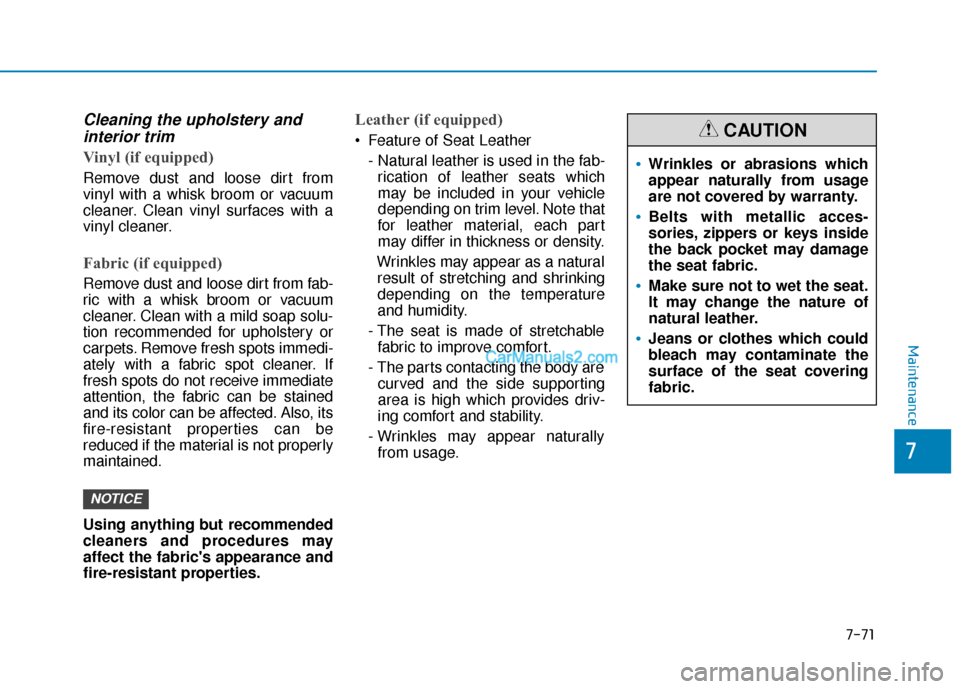
7-71
7
Maintenance
Cleaning the upholstery andinterior trim
Vinyl (if equipped)
Remove dust and loose dirt from
vinyl with a whisk broom or vacuum
cleaner. Clean vinyl surfaces with a
vinyl cleaner.
Fabric (if equipped)
Remove dust and loose dirt from fab-
ric with a whisk broom or vacuum
cleaner. Clean with a mild soap solu-
tion recommended for upholstery or
carpets. Remove fresh spots immedi-
ately with a fabric spot cleaner. If
fresh spots do not receive immediate
attention, the fabric can be stained
and its color can be affected. Also, its
fire-resistant properties can be
reduced if the material is not properly
maintained.
Using anything but recommended
cleaners and procedures may
affect the fabric's appearance and
fire-resistant properties.
Leather (if equipped)
Feature of Seat Leather
- Natural leather is used in the fab-rication of leather seats which
may be included in your vehicle
depending on trim level. Note that
for leather material, each part
may differ in thickness or density.
Wrinkles may appear as a natural result of stretching and shrinking
depending on the temperature
and humidity.
- The seat is made of stretchable fabric to improve comfort.
- The parts contacting the body are curved and the side supporting
area is high which provides driv-
ing comfort and stability.
- Wrinkles may appear naturally from usage.
NOTICE
Wrinkles or abrasions which
appear naturally from usage
are not covered by warranty.
Belts with metallic acces-
sories, zippers or keys inside
the back pocket may damage
the seat fabric.
Make sure not to wet the seat.
It may change the nature of
natural leather.
Jeans or clothes which could
bleach may contaminate the
surface of the seat covering
fabric.
CAUTION
Page 452 of 540
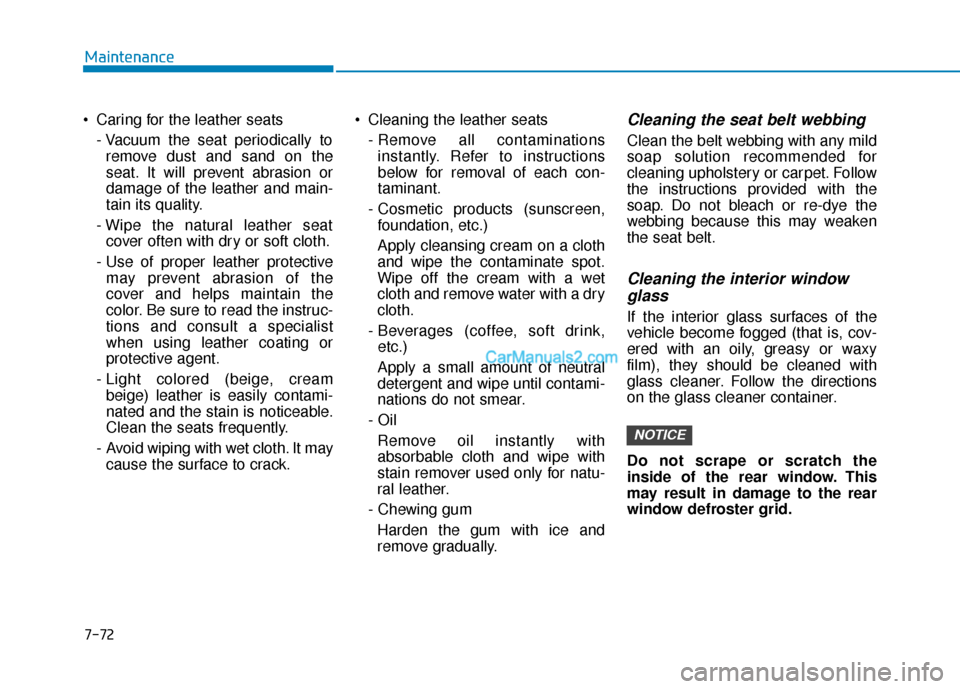
7-72
Maintenance
Caring for the leather seats - Vacuum the seat periodically toremove dust and sand on the
seat. It will prevent abrasion or
damage of the leather and main-
tain its quality.
- Wipe the natural leather seat cover often with dry or soft cloth.
- Use of proper leather protective may prevent abrasion of the
cover and helps maintain the
color. Be sure to read the instruc-
tions and consult a specialist
when using leather coating or
protective agent.
- Light colored (beige, cream beige) leather is easily contami-
nated and the stain is noticeable.
Clean the seats frequently.
- Avoid wiping with wet cloth. It may cause the surface to crack. Cleaning the leather seats
- Remove all contaminationsinstantly. Refer to instructions
below for removal of each con-
taminant.
- Cosmetic products (sunscreen, foundation, etc.)
Apply cleansing cream on a cloth
and wipe the contaminate spot.
Wipe off the cream with a wet
cloth and remove water with a dry
cloth.
- Beverages (coffee, soft drink, etc.)
Apply a small amount of neutral
detergent and wipe until contami-
nations do not smear.
- Oil Remove oil instantly with
absorbable cloth and wipe with
stain remover used only for natu-
ral leather.
- Chewing gum Harden the gum with ice and
remove gradually.
Cleaning the seat belt webbing
Clean the belt webbing with any mild
soap solution recommended for
cleaning upholstery or carpet. Follow
the instructions provided with the
soap. Do not bleach or re-dye the
webbing because this may weaken
the seat belt.
Cleaning the interior windowglass
If the interior glass surfaces of the
vehicle become fogged (that is, cov-
ered with an oily, greasy or waxy
film), they should be cleaned with
glass cleaner. Follow the directions
on the glass cleaner container.
Do not scrape or scratch the
inside of the rear window. This
may result in damage to the rear
window defroster grid.
NOTICE
Page 453 of 540
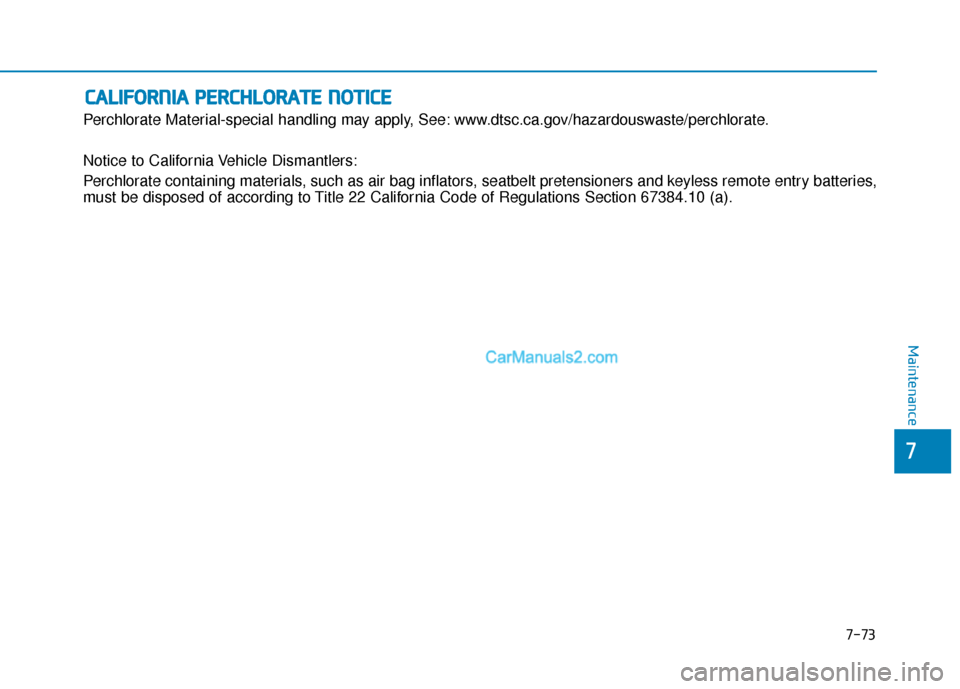
7-73
7
Maintenance
C
CA
A L
LI
IF
F O
O R
RN
N I
IA
A
P
P E
ER
R C
CH
H L
LO
O R
RA
A T
TE
E
N
N O
O T
TI
IC
C E
E
Perchlorate Material-special handling may apply, See: www.dtsc.ca.gov/hazardouswaste/perchlorate.
Notice to California Vehicle Dismantlers:
Perchlorate containing materials, such as air bag inflators, seatbelt pretensioners and keyless remote entry batteries,
must be disposed of according to Title 22 California Code of Regulations Section 67384.10 (a).
Page 454 of 540
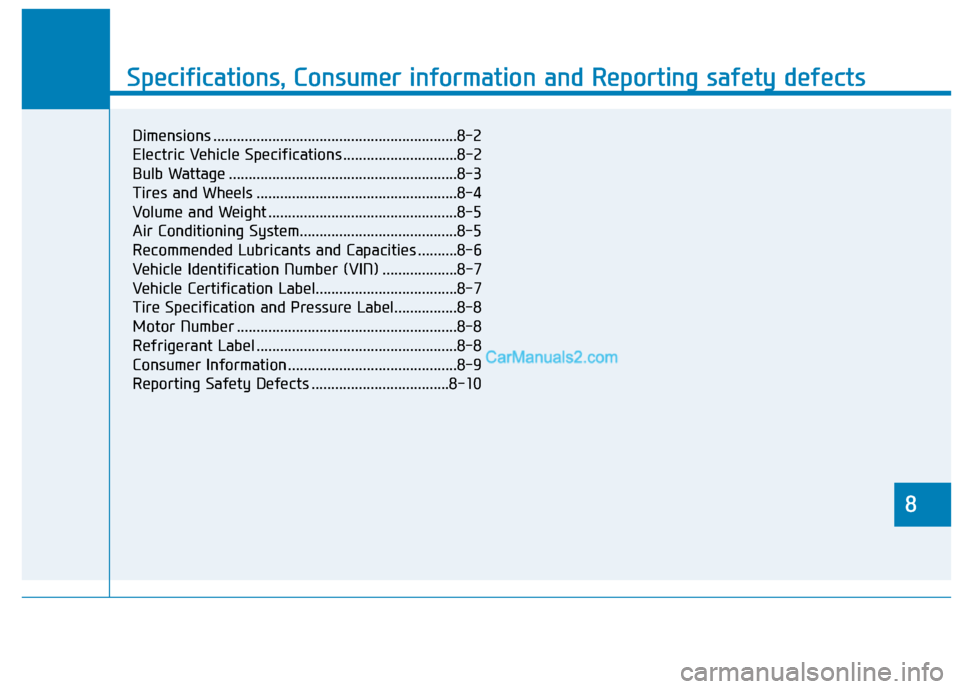
888
Specifications & Consumer information
8
Specifications, Consumer information and Reporting safety defects
8
Dimensions ..............................................................8-2
Electric Vehicle Specifications .............................8-2
Bulb Wattage ..........................................................8-3
Tires and Wheels ...................................................8-4
Volume and Weight ................................................8-5
Air Conditioning System........................................8-5
Recommended Lubricants and Capacities ..........8-6
Vehicle Identification Number (VIN) ...................8-7
Vehicle Certification Label....................................8-7
Tire Specification and Pressure Label................8-8
Motor Number ........................................................8-8
Refrigerant Label ...................................................8-8
Consumer Information ...........................................8-9
Reporting Safety Defects ...................................8-10
Page 455 of 540
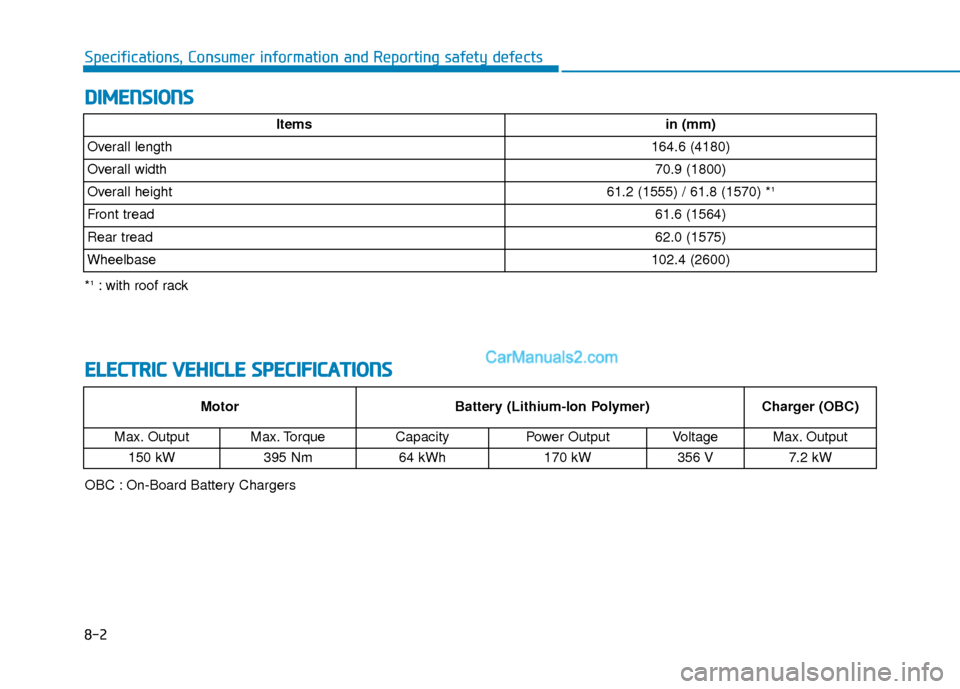
D
DI
IM
M E
EN
N S
SI
IO
O N
NS
S
8-2
Specifications, Consumer information and Reporting safety defects
Itemsin (mm)
Overall length164.6 (4180)
Overall width70.9 (1800)
Overall height61.2 (1555) / 61.8 (1570) *1
Front tread61.6 (1564)
Rear tread 62.0 (1575)
Wheelbase102.4 (2600)
E
EL
LE
E C
CT
T R
R I
IC
C
V
V E
EH
H I
IC
C L
LE
E
S
S P
P E
EC
CI
IF
F I
IC
C A
A T
TI
IO
O N
NS
S
Motor Battery (Lithium-Ion Polymer)Charger (OBC)
Max. Output
Max. Torque CapacityPower OutputVoltageMax. Output
150 kW
395 Nm 64 kWh170 kW356 V7.2 kW
OBC : On-Board Battery Chargers *
1: with roof rack
Page 456 of 540
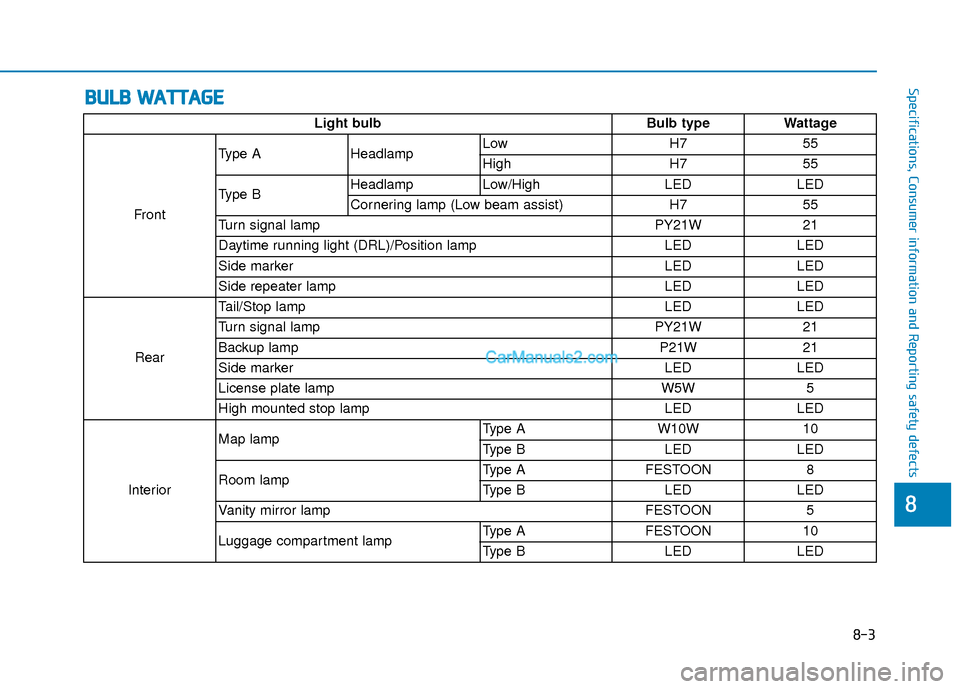
8-3
88
Specifications, Consumer information and Reporting safety defectsB
BU
U L
LB
B
W
W A
AT
TT
TA
A G
G E
E
Light bulb Bulb typeWattage
Front Type A
Headlamp Low
H755
High H755
Type B Headlamp Low/High
LEDLED
Cornering lamp (Low beam assist) H755
Turn signal lamp PY21W21
Daytime running light (DRL)/Position lamp LEDLED
Side marker LEDLED
Side repeater lamp LEDLED
Rear Tail/Stop lamp
LEDLED
Turn signal lamp PY21W21
Backup lamp P21W21
Side marker LEDLED
License plate lamp W5W5
High mounted stop lamp LEDLED
Interior Map lamp
Type A
W10W10
Type B LEDLED
Room lamp Type A
FESTOON8
Type B LEDLED
Vanity mirror lamp FESTOON5
Luggage compartment lamp Type A
FESTOON10
Type B LEDLED
Page 457 of 540
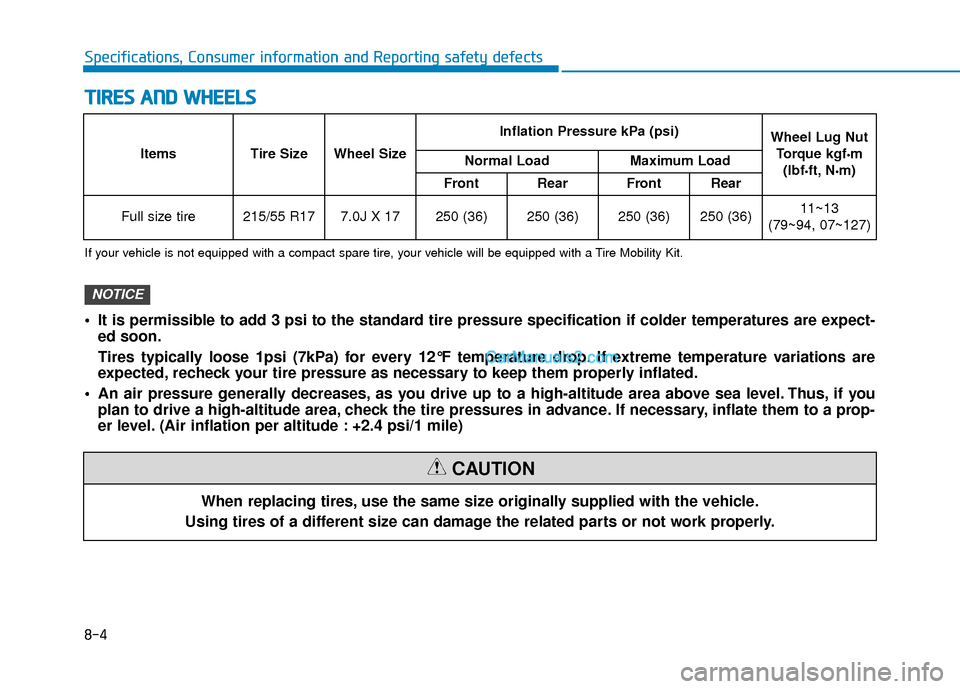
8-4
Specifications, Consumer information and Reporting safety defects
T
TI
IR
R E
ES
S
A
A N
N D
D
W
W H
HE
EE
EL
LS
S
When replacing tires, use the same size originally supplied with the vehicle.
Using tires of a different size can damage the related parts or not work properly.
CAUTION
If your vehicle is not equipped with a compact spare tire, your vehicle will be equipped with a Tire Mobility Kit.
Items Tire SizeWheel Size
Inflation Pressure kPa (psi)Wheel Lug Nut Torque kgf
•m
(lbf
ft, Nm)Normal LoadMaximum Load
FrontRearFrontRear
Full size tire215/55 R177.0J X 17250 (36)250 (36)250 (36)250 (36)11~13
(79~94, 07~127)
It is permissible to add 3 psi to the standard tire pressure specification if colder temperatures are expect- ed soon.
Tires typically loose 1psi (7kPa) for every 12°F temperature drop. If extreme temperature variations are
expected, recheck your tire pressure as necessary to keep them properly inflated.
An air pressure generally decreases, as you drive up to a high-altitude area above sea level. Thus, if you plan to drive a high-altitude area, check the tire pressures in advance. If necessary, inflate them to a prop-
er level. (Air inflation per altitude : +2.4 psi/1 mile)
NOTICE
Page 458 of 540
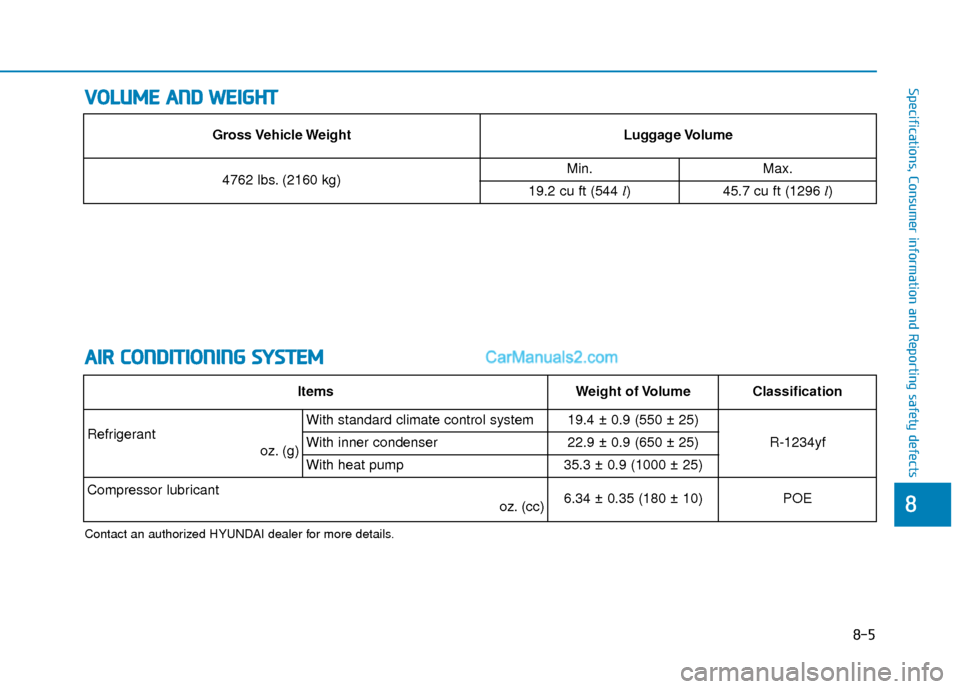
8-5
88
Specifications, Consumer information and Reporting safety defectsV
VO
O L
LU
U M
M E
E
A
A N
N D
D
W
W E
EI
IG
G H
H T
T
A
A I
IR
R
C
C O
O N
ND
DI
IT
T I
IO
O N
NI
IN
N G
G
S
S Y
Y S
ST
T E
EM
M
Contact an authorized HYUNDAI dealer for more details.
Gross Vehicle WeightLuggage Volume
4762 lbs. (2160 kg)Min.Max.
19.2 cu ft (544 l)45.7 cu ft (1296 l)
ItemsWeight of VolumeClassification
Refrigerant
oz. (g)With standard climate control system19.4 ± 0.9 (550 ± 25)
R-1234yfWith inner condenser22.9 ± 0.9 (650 ± 25)
With heat pump35.3 ± 0.9 (1000 ± 25)
Compressor lubricant oz. (cc) 6.34 ± 0.35 (180 ± 10)POE
Page 459 of 540
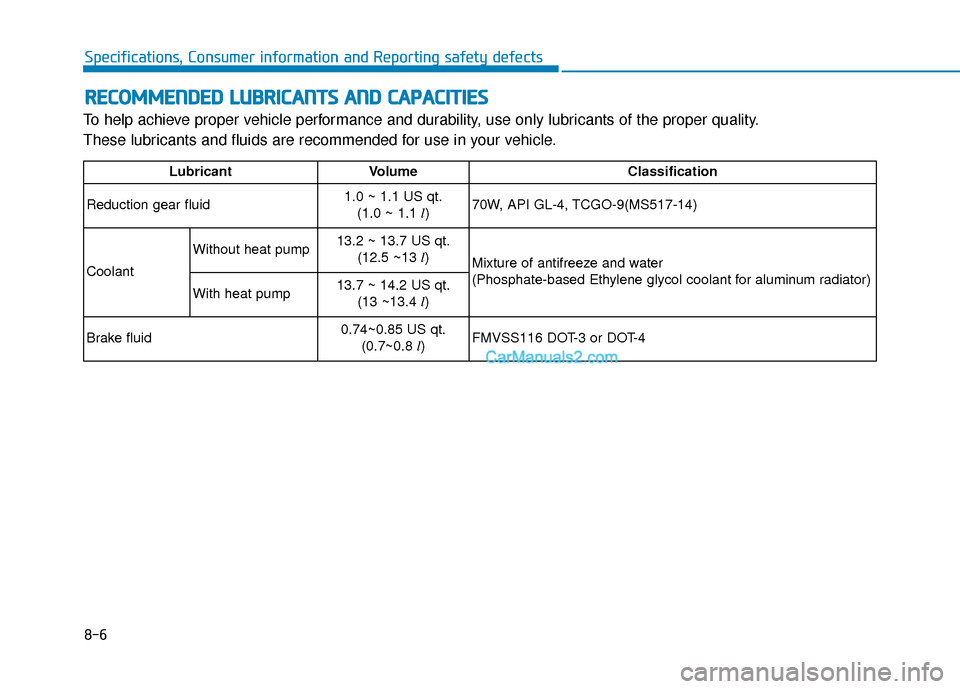
8-6
Specifications, Consumer information and Reporting safety defects
R
RE
EC
CO
O M
M M
ME
EN
N D
DE
ED
D
L
L U
U B
BR
RI
IC
C A
A N
N T
TS
S
A
A N
N D
D
C
C A
A P
PA
A C
CI
IT
T I
IE
E S
S
To help achieve proper vehicle performance and durability, use only lubricants of the proper quality.
These lubricants and fluids are recommended for use in your vehicle.
Lubricant Volume Classification
Reduction gear fluid 1.0 ~ 1.1 US qt.
(1.0 ~ 1.1 l) 70W, API GL-4, TCGO-9(MS517-14)
Coolant Without heat pump
13.2 ~ 13.7 US qt.
(12.5 ~13 l) Mixture of antifreeze and water
(Phosphate-based Ethylene glycol coolant for aluminum radiator)
With heat pump 13.7 ~ 14.2 US qt.
(13 ~13.4 l)
Brake fluid 0.74~0.85 US qt.
(0.7~0.8 l)FMVSS116 DOT-3 or DOT-4
Page 460 of 540
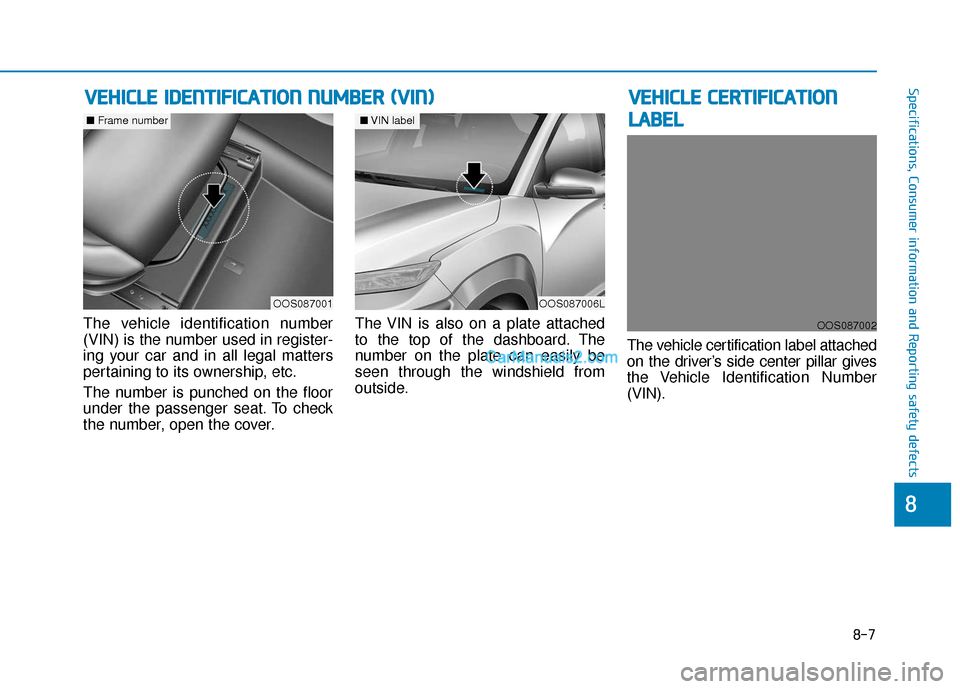
8-7
88
Specifications, Consumer information and Reporting safety defects
The vehicle identification number
(VIN) is the number used in register-
ing your car and in all legal matters
pertaining to its ownership, etc.
The number is punched on the floor
under the passenger seat. To check
the number, open the cover.The VIN is also on a plate attached
to the top of the dashboard. The
number on the plate can easily be
seen through the windshield from
outside.
The vehicle certification label attached
on the driver’s side center pillar gives
the Vehicle Identification Number
(VIN).
V V
E
EH
H I
IC
C L
LE
E
I
ID
D E
EN
N T
TI
IF
F I
IC
C A
A T
TI
IO
O N
N
N
N U
U M
M B
BE
ER
R
(
( V
V I
IN
N )
)
OOS087006L
■ VIN label
OOS087001
■ Frame number
OOS087002
V
VE
EH
H I
IC
C L
LE
E
C
C E
E R
R T
TI
IF
F I
IC
C A
A T
TI
IO
O N
N
L
L A
A B
BE
EL
L